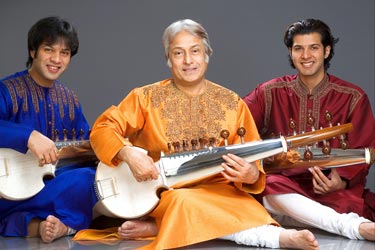| Tradition. Traditional Indian dress rules in the audience as well as onstage. Amjad Ali Khan and his two sons, Amaan and Aayan, are respectively sixth and seventh generations in the Bangash family of sarod masters. When the sons come onstage after intermission, they each stoop, touch hand to father’s foot and to their own heads, before taking a seat on the floor, arranging the instrument, and covering the protruding left foot with a shawl as a gesture of respect to the audience members. Aayan, the elder son, announces that the brothers have their father-guru’s permission to play. Tradition. |
|
 |
|
| The sarod (from the Persian ‘sarood’, meaning melody) is a refined version of the Afghan ‘rabab’, a four stringed (plus four drone and rhythm strings and eleven steel sympathetic strings) folk instrument brought to India by their ancestor 200 years ago. Amjad Ali Khan says, “Whoever is playing the sarod today learned directly or indirectly from my forefathers”.
A smaller instrument than the sitar, the sarod is distinguished by its ‘human’ singing voice. This effect is made possible partly by the traditional goatskin top that covers the teak body, and more importantly by an innovation to the rabab introduced by the third generation ancestor, namely, the replacement of the fretted fingerboard by a smooth steel fingerboard which allows the player to perform swooping melismatic slides 7 or more notes up and down the fingerboard. This changes the sarod from a staccato instrument into a more lyrical instrument whose repertoire includes compositions based on vocal arrangements. The musicians repeatedly dip their two forefingers in a small pot of oil to facilitate this slide.
A further refinement, as Amjad Ali Khan explained and demonstrated, is that strings damped by the fingertip produce a dull gutty sound, while his family way is to stop the strings with the fingernail, producing a clear, ringing tone. This technique occasions a certain amount of onstage nail filing to complement the prolonged tuning sessions between melodies. The instrument is plucked with a coconut shell plectrum.
The playing was spectacular as it moved from the slow, contemplative opening mood of most pieces, to a frenzy of melodic activity by the master himself, solo, or accompanied by his sons and the two excellent tabla players, Vineet Vyas and Samir Chatterjee. Overall, the concert was entrancing. Traditionally, there are displays of call and response, where the soloist rattles off a complex series of riffs and the accompanist responds by repeating them. In this case, the father tested both sons, and both came through without dropping a note, bringing a huge warm smile to the face of the father.
This kind of display brings to mind that this performance is taking place while Toronto is deep into the Downtown Jazz Festival, where the soloist, like Alto man Kenny Garrett will blow a riff, leave a break, and the drummer or a bass will answer, by doing his own thing, not by repeating the soloist’s thing. Another kind of tradition.
|


